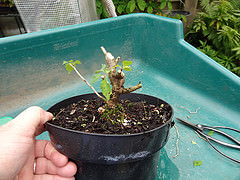Why Your Plants Need Pruning
 "And what is so rare as a day in June? Then, if ever, come perfect days ..." (James Russell Lowell). When I mentioned this exuberant quote to some friends, I was met with blank looks. Apparently, they'd never studied Lowell's poem in school -- because they grew up in Australia. In the Southern Hemisphere, of course, the seasons are reversed and June is a time of less-than-perfect weather.
"And what is so rare as a day in June? Then, if ever, come perfect days ..." (James Russell Lowell). When I mentioned this exuberant quote to some friends, I was met with blank looks. Apparently, they'd never studied Lowell's poem in school -- because they grew up in Australia. In the Southern Hemisphere, of course, the seasons are reversed and June is a time of less-than-perfect weather.
That got me thinking. I have come to the conclusion that my Christmas cactus must be a contrary Australian variety. A plant that normally bursts forth with gorgeous pink blossoms during the short dark days and long nights of December (hence the name), mine put out nary a bud all winter. Instead, it's chosen the sunny month of June to flower, reversing the usual seasonal pattern very nicely, thank you. On the other hand, the cactus may simply be responding to the good pruning I gave it recently.
Why Prune
Ironically, "wounding" a plant with a good prune can result in healthier, more vigorous growth when it's done right. Pruning includes removal of dead or damaged stems and branches, those badly infested with pests, and older growth which may be more susceptible to diseases. Not only does this stimulate branching and, depending on the type of plant, lead to increased flower or fruit production (as with indeterminate tomatoes, for example), it provides additional benefit. Cutting back excessive growth will allow more sunlight and air to reach the plant. It may also be used to shape the plant into a neater, more compact and attractive shape, for bonsai or topiary gardens. Pruning large branches off bushes or trees can be important as a safety measure, for instance, to prevent contact with utility company lines.
When to Prune
For both houseplants and outdoor spring-flowering plants, the best time to prune is in the late spring to early summer, when the days are warming and the sun shines for many hours. This will allow the plant to recover from the stressful experience of being cut back. Prune right after blooming. Trees and summer-flowering plants will thrive if they are pruned at the end of winter or the beginning of spring. However, particularly if required to control disease or infestation, pruning may be done at any time the weather is not overly harsh (avoid the severest cold of winter as well as extremely hot, dry summer days).
When you are planning a wedding or other gala event in your garden, try to schedule your pruning 2-4 months prior. This will allow your plants time to recover sufficiently to provide a lovely background for your celebration. (If this timetable is not possible, you may fill out your garden with potted plants brought in for the occasion.)
How to Prune
A variety of tools may be used for pruning, depending on the size of the plants. Your fingertips are all you need for pinching back small flowers ("deadheading"). Use gardening shears for stems or thin branches up to 1/2" in diameter. Loppers are recommended for branches to a maximum of 1 1/2". For both shears and loppers, bypass style is recommended over anvil, which tends to crush rather than cut cleanly. Tri-edge folding saws are designed for cutting branches from 1 1/2-3". Pole pruners are handy when you need to reach high growth. The pruning of larger trees is best left to professional landscapers, as haphazard trimming can threaten both the health of the trees and the safety of nearby plants, buildings, or other property, not to mention the would-be pruner him- or herself.
Clean sharp tools are healthiest for your plant. Blades should be sharpened regularly and disinfected with bleach, rubbing alcohol, or a commercial plant nursery product to discourage disease from making its way in through the cut.
Prune when plants are dry and angle your blade slightly. This will prevent water from accumulating in the cut end of the stem or branch, which could promote fungal growth.
Laura Firszt writes for networx.com.
Looking for a Pro? Call us (866) 441-6648

Landscaping Average Costs
Landscapers Experiences

Landscaping Turns A Weed Patch Into A Great Little Zen Garden

Friendly And Professional Lawn Service Earns My Loyalty



